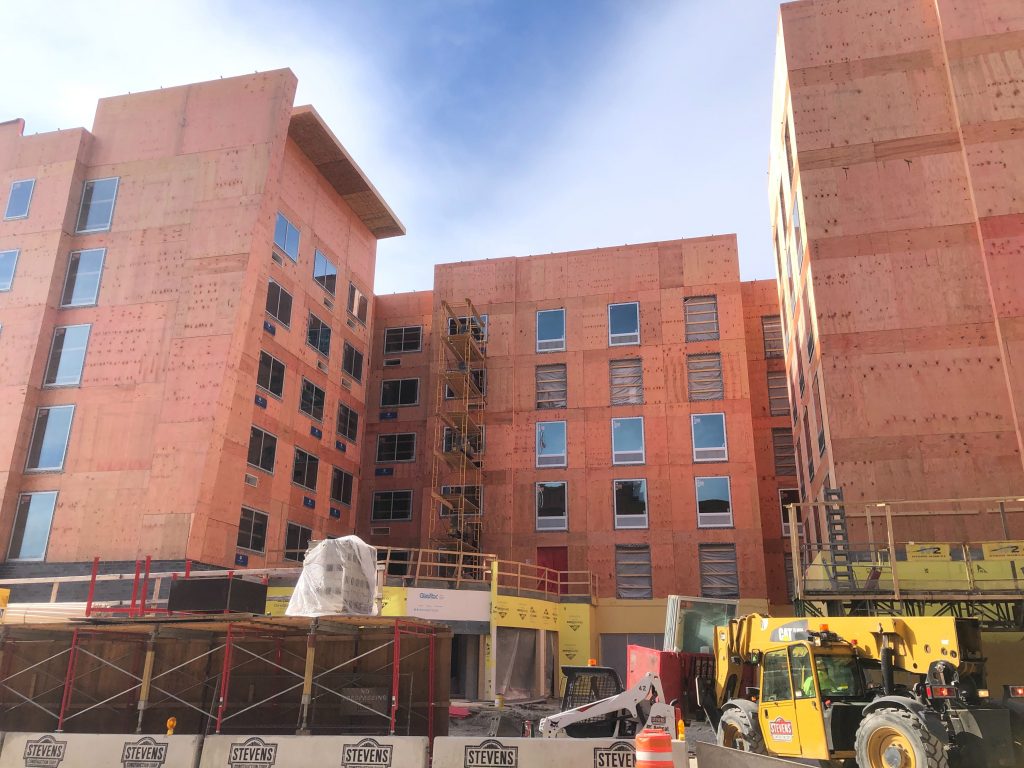Milwaukee Construction Costs Growing Faster Than National Average
Tariffs pushing costs up across the United States.

Construction of a Holiday Inn Express, Home2 Suites by Hilton and Tru by Hilton on N. Jefferson St.
Photo taken Feb. 7, 2020 by Jeramey Jannene. All Rights Reserved.
Construction costs for nonresidential buildings in Milwaukee and nationally rose more in the first three months of the year than in the same period of 2024, underscoring the ripple effects of shifting global trade policy and tariffs in the supply chain.
That data comes from the quarterly Mortenson Construction Cost Index, which tracks nonresidential construction costs in Milwaukee, Chicago, Minneapolis, Portland, Denver, Phoenix and Seattle.
Nationally, costs tracked by the index rose by 2.24% over the first quarter and 3.9% compared to the previous 12 months. In Milwaukee, costs rose 2.6% in the three months of 2025 and 4.3% over the previous 12 months.
For comparison, in the first quarter of 2024, the costs tracked by Mortenson increased by 0.34% nationally for the quarter and 1.89% over the previous year. Costs increased by 1.3% in Milwaukee in the first quarter of 2024 and 2.3% over the previous 12 months.
The report states that the increases in construction material costs to start 2025 came “after a period of softening prices.” It attributed the shift to “the evolving tariff environment, which is influencing aluminum glazing systems and, indirectly, structural steel pricing.”
While the report noted that supply chains and labor markets have remained steady, it tracked flat growth in the Milwaukee area’s building construction workforce through three months of 2025 compared to the same period last year. In both quarters, the Milwaukee metro area averaged 34,700 building construction workers, according to Mortenson.
The Turner Building Cost Index tracked slightly more modest increases in nonresidential construction costs nationally than Mortenson. Turner tracked a 1.18% increase in costs through the first quarter and a 3.6% increase over the previous year. That was a steeper quarterly increase than Turner tracked to start 2024, but a smaller annual increase.
Tim Kippenhan is president and chief operating officer of Neenah-based Miron Construction, which works exclusively on nonresidential projects for businesses, schools, municipalities and faith groups. He said the construction industry saw major cost increases in the years immediately following the COVID-19 pandemic. In 2024, he said those cost increases slowed, but prices didn’t come down.
He said costs tended to rise with tariff announcements early in the year but they have slowed over the last eight weeks or so.
“Up until the word ‘tariffs’ came out, most people felt [costs were] going to be flat,” he said. “When some of the tariffs were announced, then I think everybody got nervous. We saw a little bit of a bump at that point, specifically on the electrical, mechanical components, and then on items that incorporated steel.”
Kippenhan said any major building has what’s called a “switchgear,” or a circuit box in a residential building, as well as fire alarm systems and air handling systems, which all use a lot of electrical components. He said many of those components come from outside the United States.
Earlier this year, President Donald Trump raised tariffs on all steel and aluminum imports to 25%. Earlier this month, he doubled the tariffs to 50%.
At Miron, Kippenhan said a lot of the structural steel it uses comes from producers in the Midwest.
“We’ve not seen the price increases on the structural steel standpoint,” he said. “[There is] still some nervousness out there, but we have not really seen that price increase, for the most part.”
Business owners say shifting tariff policies create harmful uncertainty
Beyond component costs, Kippenhan said labor costs also continue to climb and business owners across industries would like to see more clarity when it comes to the tariff situation moving forward.
“When I talk to other business owners, and not just construction-related, I think a lot of people are just looking for clarity and just are trying to understand the rules so that they can make informed decisions and move forward accordingly,” Kippenhan said.
The Mortenson and Turner Cost reports included details about nonresidential construction costs, but they did not include details on residential construction.
The Wisconsin Builders Association said it did not have state-level data on residential construction costs in the first quarter.
ABC Supply, a Beloit-based roofing supply company founded by Republican mega-donor Diane Hendricks, has posted a host of price increase notices from manufacturers of everything from roofing and siding to windows and doors.
David Belman, president of Waukesha-based homebuilder Belman Homes, said lumber prices spiked after the pandemic. But he said those prices were “fairly static” last year.
“February through April, when all the tariff stuff [was] really ramping up, the lumber futures went up,” Belman said. “Then recently, it’s pretty much come back down to very close to where it was at the beginning of the year.”
Beyond lumber, he said the company has faced increased prices for roofing, windows, garage doors and plumbing fixtures.
“If an average year is 3% or 3.5%, we might be up 5 to, at worst, 7% on construction costs this year,” Belman said.
Andy Selner, owner of homebuilder Alair Homes Green Bay, said his costs typically increase from year to year by between 3 and 5%. This year, he said there were a few products that took a 5 to 10% increase, but it hasn’t been “the big ticket items.”
Selner said many of his vendors are domestic companies, which has helped insulate the business from some tariff-related cost increases.
“That’s a huge reason why, and part of that too, is a lot of our manufactured products — like windows, that’s a big ticket item in the house — are manufactured in the United States,” he said. “That definitely helps our industry in being able to source American made products.”
Index finds Milwaukee construction costs rose more than national average in early 2025 was originally published by Wisconsin Public Radio.
If you think stories like this are important, become a member of Urban Milwaukee and help support real, independent journalism. Plus you get some cool added benefits.




















